Student Work
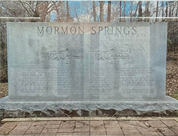
The Church of Jesus Christ of Latter-day Saints was organized on April 6, 1830. Missionaries first arrived in northeastern Mississippi in 1839. Here at Mormon Springs many converts to the church were baptized. Using stones to dam the stream, they made at baptismal font just to the east of the ford that then crossed the stream. The Buttahatchie branch of the church was organized here in 1843, with William Crosby as branch president. A small church was built on the West side of the ford to serve over 200 members.
From this site on April 8th, 1846, the first Saints left for their trek west under the direction of John Brown. They were the first to establish a religious colony in the West since the Spanish priests of 1769. Several members of this group, known as the Mississippi Mormons, were also among the advanced scout party who first entered the Salt Lake Valley on July 24, 1847. They had already planted potatoes, beans, and buckwheat. True to their Southern tradition, these faithful Saints had also planted a turnip patch.
Many of these early converts were marvelous frontiersman, resourceful colonizers and shrewd traders. Because of their abilities, nearly all of them were eventually called to lead Mormon colonies to Colorado, Utah, California, Oregon and other areas of the West. They were valiant in their love of God, their prophet, and their religion.
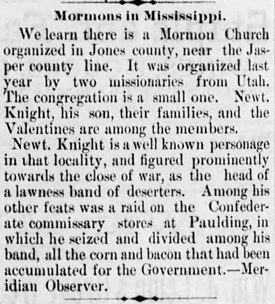
Latter-day Saints, commonly referred to as Mormons, first arrived in Mississippi in 1839 with the arrival of missionaries in Tishomingo County. Since then, they have come to number nearly 22,000 people in the state. Their church is headed by a presidency centered in Salt Lake City, Utah, with a hierarchical structure not too unlike those of Roman Catholic and Anglican churches. Identifying as Christians, they believe in the divinity of Jesus of Nazareth and in the Old and New Testaments. In addition, breaking with mainline Christian orthodoxy, Latter-day Saints believe in several additional scriptures and unique doctrines; among these are the Book of Mormon, which they believe to be the translated record of ancient Israelite exiles in the Americas that testifies of Jesus' visit to them, and the rejection of trinitarianism in favor of viewing God the Father, Jesus Christ, and the Holy Ghost as three separate gods, Latter-day Saints in Mississippi come from a variety of origins and personal backgrounds, and have varying beliefs and commitments to their church, but have a unique and recognizable place in Mississippi's cultural fabric.
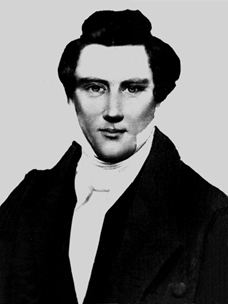
Joseph Smith is believed by Latter-day Saints to be the first prophet of Jesus’ established church since the apostle Peter. They believe that he restored the church and received apostolic succession, passed to his successors, after it was lost upon the deaths of the original apostles, which they term the Great Apostasy.
LDS churches in/near Mississippi:

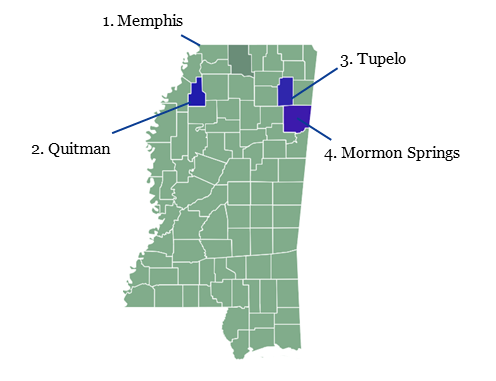
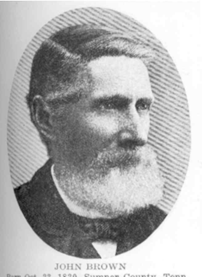
Portrait of John Brown, a Latter-day Saint missionary who led the Mississippi Saints out to Utah, as described in the Mormon Springs Monument. (Source: David F. Boone, BYU)
LDS FAQ:
- Q: Why do Latter-day Saints wear special underwear?
A: These items of clothing, called temple garments, are received after a special temple ceremony and considered sacred, not unlike a yarmulke or hijab. - Q: Why were African-Americans not allowed to be ordained until 1974?
A: Racism was a horrible fact of the 20th century, and the church has officially condemned its past policies and said there is no good reason for them. A confluence of social factors, both common among the American public and unique to the Latter-day Saints, led to this harmful practice being instituted under the Brigham Young presidency. - Q: Why do Latter-day Saints not use the symbol of the crucifix in official capacities?
A: This is a cultural eccentricity with a number of folk origins. Some prefer the practice because it emphasizes the life and ministry of Jesus rather than his death, but there is some evidence its original source is in Protestant iconoclasm and anti-Catholicism. - Q: What about polygamy?
A: Polygamy was the normative form of marriage in early Mormonism but was banned in 1890. Men can remarry after their wife's death and have multiple wives in the afterlife, however. - Q: So where does the Book of Mormon take place? Are there Nephite ruins we can visit?
A: The location of the events described in the Book of Mormon is controversial among Latter-day Saints, including hypotheses that it takes place in Mesoamerica or Upstate New York. The lack of direct archaeological evidence is seen as evidence by skeptics that the events are fictional, and this criticism is longstanding.
On display, from our collections:
The Book of Mormon, translated by Joseph Smith, Jr. Compared with the original manuscript and the Kirtland edition of 1837, which was carefully re-examined and compared with the original manuscript by Joseph Smith and Oliver Cowdery.
BX8623 1953
Mormon doctrine / Bruce R. McConkie
BX8605.5.M3 1966
Gospel principles / published by the Church of Jesus Christ of Latter-day Saints
Bx8635.2.G67 1988
Contemporary Mormonism : Latter-day Saints in modern America / Claudia L. Bushman
BX8611.B87 2006
The Book of Mormon : another testament of Jesus Christ. The Doctrine and covenants of the Church of Jesus Christ of Latter-Day Saints
BX8623 1981a
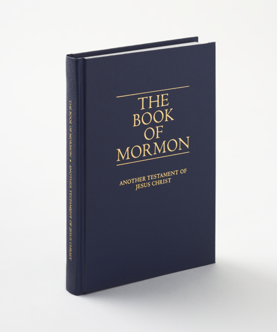
Sources:
1: Mormon Springs Monument. Photo by Mason Williams, 2022.
2: Vicksburg Evening Post, July 26, 1883.
3: Joseph Smith Junior, Daguerrotype photograph by Lucian Foster, 1843.
4: Ray Luce, lucepics. https://www.flickr.com/photos/lucepics/
5: The Church of Jesus Christ of Latter-day Saints.
6: David F. Boone, Brigham Young University.
7: Fullrabb, Wikipedia.
8: Text by Mason Williams, 2022.
9: Book of Mormon, early 20th century.
10: Mormon Doctrine, Bruce R. McConkie.
11: Gospel Principles, The Church of Jesus Christ of Latter-day Saints.
12: Contemporary Mormonism, Claudia Bushman.
13: Book of Mormon, contemporaneous.
